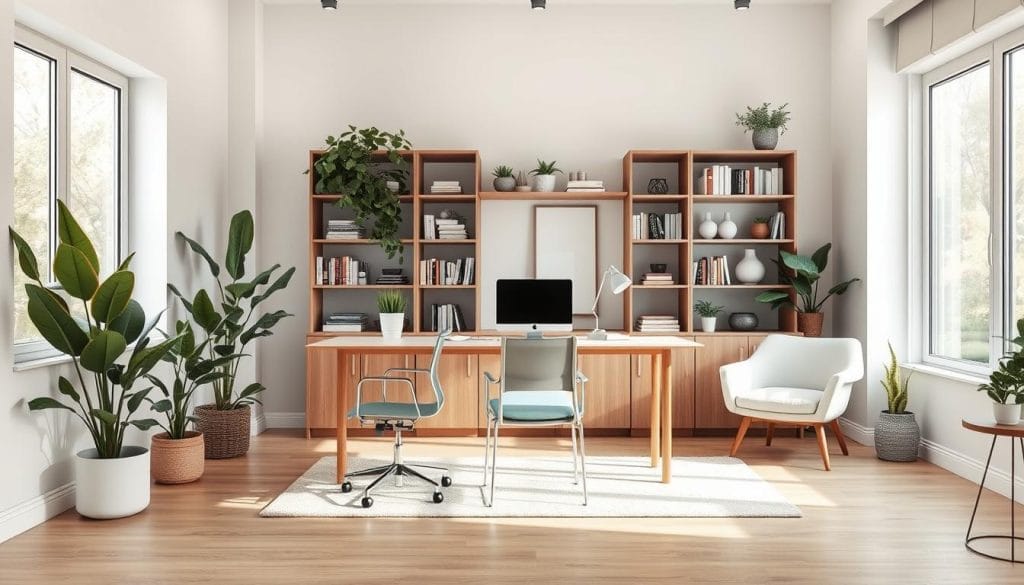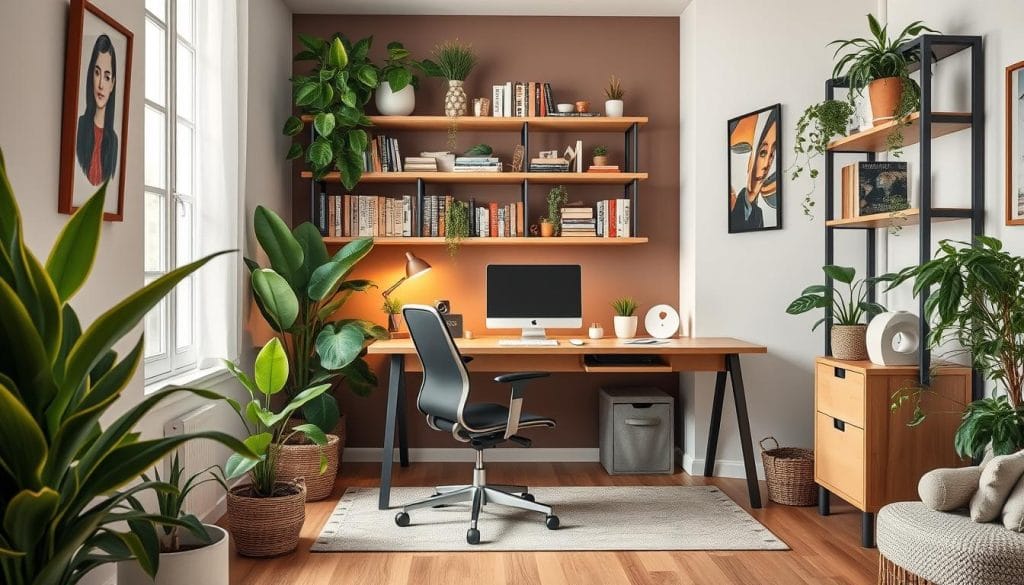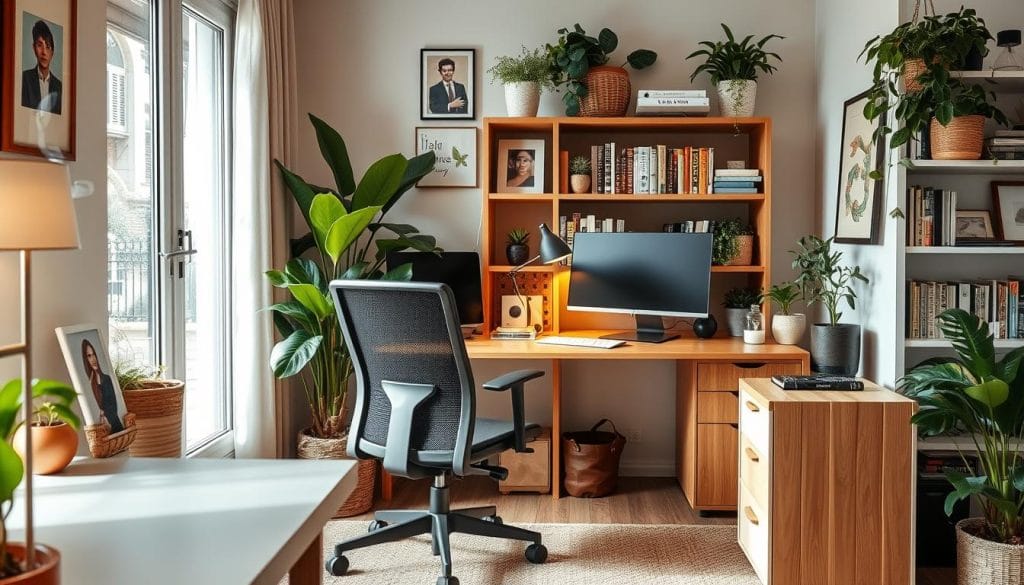Have you dreamed of a workspace that mirrors your style and boosts your productivity? You’re not alone. Many seek a home office that combines beauty with efficiency, a need that’s grown in the work-from-home era. Imagine a place like a Parisian apartment with beautiful Nuvolette wallpaper and sleek glass doors. Or an office created by Delia Mamann that feels more like a chic room than a work spot.
If the cottage look with metal-framed glass walls calls to you, or the mid-century modern style with guitars does, listen up. Personalized workspaces are key to more creativity and focus. See Bernard & Speziale’s condo office as an example. It pairs a warm ochre with walnut wood for a cozy, attractive setting.
Picture turning a messy area into a clean, stylish space like Aly Velji’s office. It has a beautiful live-edge desk with neat storage. Or imagine a colorful, lively room full of bold patterns. Cynthia Ferguson’s condo office is such a place. These spaces show that organizing your workspace can also be refreshing and motivating.
Let’s dive into these 10 amazing home office designs. They’re sure to spark your creativity and improve your productivity. We want to help make your workspace a place where you do your best work!
Transform Your Space with Effective Layouts
Making your home office better starts with a good layout. You want to use space wisely and make cozy areas. The right setup really changes things!
Open-Concept vs. Closed Spaces
Choosing between open or closed layouts for your office matters a lot. Open spaces are great for those who like to move and interact. But, closed areas are best for privacy and focus. They’re perfect for concentration.
Zoning Your Workspace
Zoning is key to dividing your office into different task areas. It keeps you neat and on task. Use simple décor to mark zones without clutter.
Importance of Traffic Flow
Good traffic flow in your office boosts productivity. Arrange desks and storage to avoid blockages. It’s not just about walking easily. It’s also ensuring the right chair positions and bright lights.
Check out this layout comparison:
| Factor | Open-Concept | Closed Spaces |
|---|---|---|
| Environment | Breathable and interactive | Private and focused |
| Noise Level | May be higher | Generally quieter |
| Furniture Placement | Flexible, encourages movement | Static, supports deep work |
Choose the Right Furniture for Comfort
Designing a comfortable and productive home office is important. You’ll need ergonomic furniture, versatile desks, and your own décor style. Let’s look at how each part helps create an inspiring work area.
Ergonomic Chairs and Desks
Start with the right ergonomic furniture for a great workspace. Desk chairs that support your back can stop pain and fatigue. This makes you more productive. Also, put your computer screen at eye level to reduce neck strain.
Choose desks that can adjust in height to fit anyone and any style of working. A height-adjustable desk, for example, is great for small spaces. It gives you ergonomics without taking up too much room.
Multi-Functional Furniture
Using desks with more than one function saves space and is smart. A desk with a hutch, for example, gives you storage and a place to work. This is perfect for small areas.
Organize cables with clips or trays to avoid accidents and keep the area neat. A soft rug adds warmth and cuts down on noise. This makes your office feel calm and helps you focus.
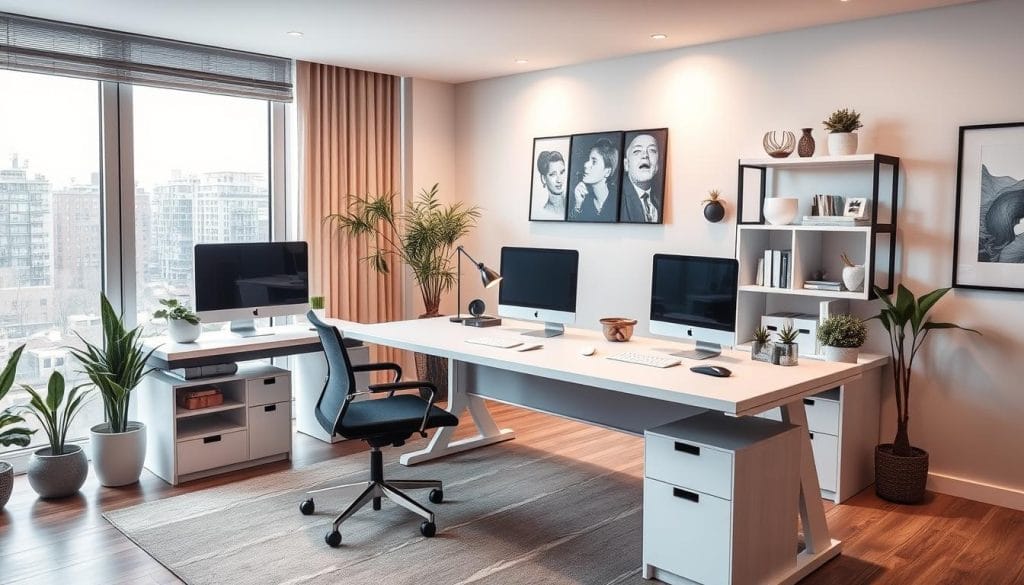
Personal Touch with Decor
Decorating your office makes it uniquely yours. Hang art, add plants, or set up a gallery wall to boost your mood and motivation. A good lamp can lessen eye strain and make the space comfy.
Use desk organizers to keep things tidy and everything within reach. Bookshelves and boards that you can write on or pin to are not just useful. They also make your space look good and encourage you to be more creative and get more done.
Harness Natural Light to Boost Mood
Natural light greatly improves our mood and how much we get done. Natural lighting tips can make your home office better. Offices with more natural light see a 20% jump in productivity.
Positioning Your Desk
Putting your desk in the right spot is key to using natural light well. Place your desk by a window to get the most light. This can make you 15-20% more productive and happier. People who like being around others might enjoy open, bright spaces. Those who prefer being alone may like quiet corners with sunlight.
Adding Reflective Surfaces
Using reflective surfaces in design helps increase natural light in your space. Adding mirrors, whiteboards, or shiny furniture can spread light. This makes the room feel brighter and more open.
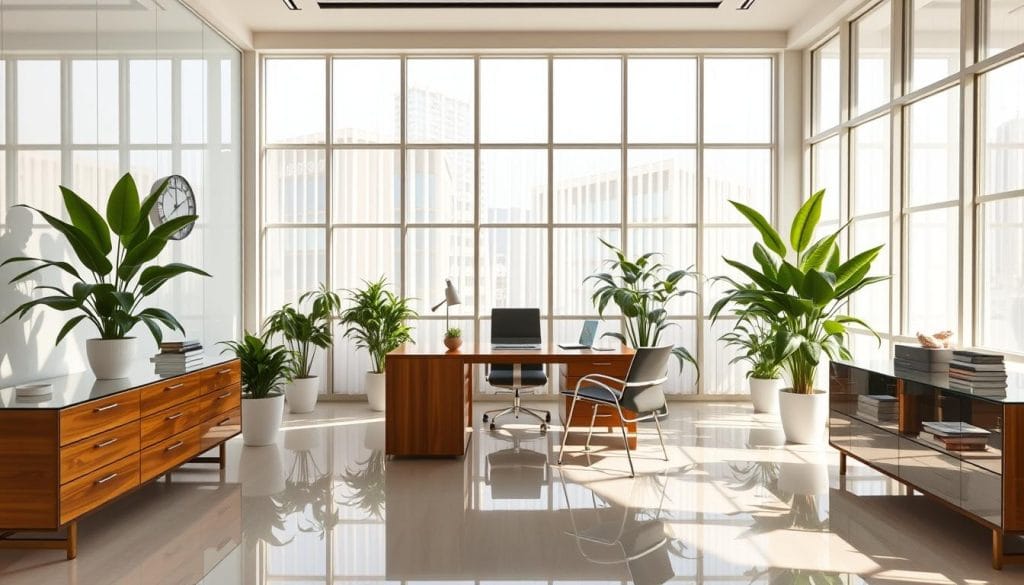
Choosing the Right Window Treatments
It’s important to pick effective window treatments to manage light. Sheer curtains let in light softly and reduce glare. Blinds with adjustable slats let you control how much light comes in throughout the day.
Incorporate Technology for Efficiency
Embracing technology can make your home office a place where you do your best work. With the right tech gadgets for productivity and smart home accessories, everything works together smoothly.

Smart Home Accessories
Smart home office technology includes things like smart assistants and systems that do things for you. Google Assistant and Amazon Alexa can do tasks, change settings, and make your work flow better. These devices help you focus more on your work and control your office without hands.
Essential Office Gadgets
Investing in important office gadgets can boost your work output a lot. Using two monitors at once improves multitasking and how well you organize your work. Noise-canceling headphones are key for keeping focused by keeping out unwanted noise.
Smart desk accessories like standing desks and ergonomic keyboard trays make working more comfortable and productive. These tools are key to making a work-friendly space at home.
Apps for Task Management
Apps for organizing your tasks are a must-have to stay on track and efficient. Apps like Trello, Asana, and Microsoft Teams are great for overseeing projects and working with your team. Cloud tools like Google Workspace and Microsoft 365 make working together and sharing documents easy. Adding these apps to your everyday routine helps keep your tasks in order and easy to handle.
| Feature | Benefits |
|---|---|
| Smart Assistants | Automate tasks, control settings, streamline workflow |
| Dual Monitor Setups | Improve multitasking, better workflow organization |
| Noise-Canceling Headphones | Maintain focus, block distractions |
| Task Management Apps | Track projects, collaborate, manage tasks efficiently |
To learn more about making your home office better, check out this guide. It breaks down how adding technology can boost your workstation’s efficiency and productivity.
Use Color Psychology to Enhance Focus
Colors play a big role in our feelings and how well we work. Let’s see how using color psychology helps choose the best colors for work.
Calming Colors for Concentration
Some colors help you stay focused in your home office. Blue is known for boosting the mind, easing stress, and helping with focus. It helps keep your thoughts clear and your space tidy.
Green brings balance and peace. It also reduces stress and is good in places where staying calm is important, like in doctors’ offices.
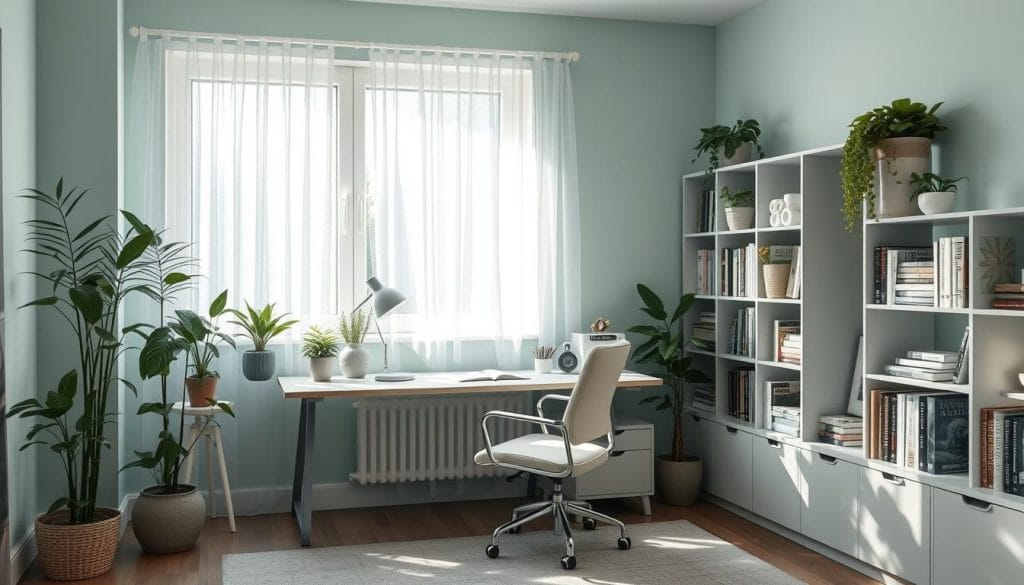
Vibrant Hues for Creativity
For those who need creativity, bright colors can help a lot. Yellow brings joy and sparks new ideas. It makes you feel confident and warm.
Orange mixes energy and emotional uplift. It links to joy and fun. But, it’s best to use it lightly because it can make you feel hungry.
Balancing Neutrals with Accents
It’s key to mix neutral tones like white, black, or gray with lively colors. White makes a place feel bright, while black shows power. To keep your office welcoming, add bits of red, blue, or green. These colors help with work, creativity, and feeling steady.
Create a Distraction-Free Environment
It’s key to set up a workspace without distractions for better focus and more work done. Whether your work involves big projects or creative tasks, a space without interruptions is vital. Learn about making your office quiet, dealing with noise, and organizing your desk for top productivity.
Soundproofing Your Office
To cut distractions, soundproofing your office is a smart move. Things like acoustic panels, heavy curtains, and rugs absorb sound. Sealing doors and windows also blocks noise. Did you know 43% of people working from home use noise-canceling headphones to avoid distractions? Making your office quieter can help you concentrate better.
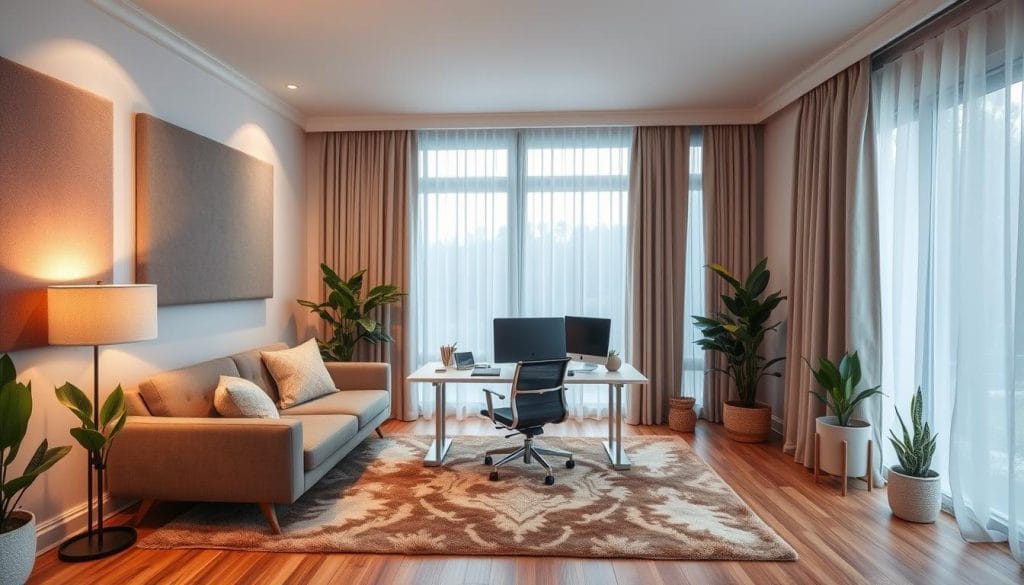
Managing Outside Noise
Handling noise from outside is also crucial. If you can’t soundproof entirely, try white noise machines or apps for background sounds. Picking quieter times for deep work helps too. Did you know almost 70% of home workers need quiet to be productive? Techniques like these can control external noise well.
Organizing Your Desk
Cleaning up your desk area is important for a distraction-free space. A tidy desk boosts your focus. Use organizers, drawer dividers, file folders, and ways to hide cables to stay neat. Remember, 78% of remote workers say a clean office makes them more productive. Here are some tips to organize your desk:
- Declutter regularly: Remove items you don’t use daily from your desk.
- Use desk organizers: Invest in trays, pen holders, and folders.
- Limit cables: Use cable ties or sleeves to keep cords out of sight.
- Keep essentials within reach: Place planners, notebooks, and pens near your workspace.
Good desk organization leads to a nicer workspace and improves focus and productivity. Using these soundproofing and organization strategies can make your office a better place to work.
Personalize Your Workspace for Inspiration
In this work-from-home age, making your office yours is key. It’s not just for looks — it boosts your motivation. We’ll see how art, quotes, and vision boards can make your office better.
Include Meaningful Artwork
Art is more than something pretty. It sparks inspiration. Choosing art that clicks with you brings your space to life. Whether a calm scene, bold abstracts, or personal snaps, the right pieces can brighten your mood.
Use Inspirational Quotes
Words have power! Hanging quotes that speak to you can inspire every day. Frame them and place them where you see them often. They can lift your spirits and keep you aimed at your dreams.
Create a Vision Board
A vision board maps out your dreams. It includes pictures and items that echo your goals. Seeing your goals daily helps focus your efforts. It’s a powerful tool in reaching your dreams.
Adding these touches turns your office into an inspiration hub. It’s more than just arranging your space; it’s about making a spot where you excel. Your home office can be your path to success. 🖼️✨
Integrate Plants for Health Benefits
Adding plants to your home office helps your health, cleans the air, and makes your workspace prettier. Learn how indoor plants can make you feel better and work better.
Best Indoor Plants for Office
Picking the right office plants matters. Here are some great ones:
- Snake Plants: These tough plants are okay with some neglect. They can grow in different lights and need water every 2-4 weeks.
- Spider Plants: They are easy to care for, grow more plants easily, and clean the air well with water every 1-2 weeks.
- ZZ Plants: They do well in low light and need water about every 4 weeks, which is great for busy people.
- Peace Lilies: They’re good in low light and need water when their leaves sag. They also add moisture to the air.
Putting these plants in your office can make it a nicer, more motivating place to work. Check out the best plants for boosting productivity at home.
Air Quality Improvement
Plants are great at cleaning the air. NASA says that office plants can remove up to 87% of toxins in the air in 24 hours! It’s smart to have at least one plant for every 10 square meters in your office.
| Plant | Light Conditions | Watering Frequency | Air Quality Benefits |
|---|---|---|---|
| Neon Pothos | Low to bright, indirect | Every 1-2 weeks | Removes benzene, toluene, formaldehyde, carbon monoxide |
| Peace Lilies | Moderate to low | When leaves droop | Adds humidity |
| Spider Plants | Low light to well-lit | Moderate, every 1-2 weeks | Easy maintenance, propagates easily |
| Boston Ferns | Bright, indirect | Keep soil consistently moist | High humidity environment, moisture boost |
Cleaning the air with plants makes a healthier place and can reduce stress too. Being near nature lowers blood pressure and stress hormone levels.
Biophilic Design Principles
Biophilic design connects nature with indoor spaces. Adding plants to your decor makes your workspace calm and helps you think. This method improves focus, happiness, and work performance.
Think about making a vertical garden with ferns, succulents, or hanging plants. You save space and bring nature inside. Bonsai trees can add peace and balance, fitting with the biophilic design idea.
Indoor plants don’t just clean the air—they also help our mental health. Using a biophilic design in your office helps you do well at work and feel good in life.
Set Boundaries to Maintain Work-Life Balance
Working from home can make it hard to separate job from personal life. Setting clear limits helps you stay focused without losing your personal time. Here are some useful tips to find that balance.
Designated Work Hours
One important step is to create work boundaries with fixed hours. Start and end work at the same times every day. This sets a routine, letting your brain know when to work and relax. Over one-third of people work from home, says a Bureau of Labor Statistics report. So, having a strict schedule is crucial.
Physical Separation of Spaces
It helps to have a special spot for work at home. Camille Bradbury of Matchr says different areas for work and rest boost focus and happiness. Use a separate room or dividers for your office space. If space is tight, try a foldable desk.
Communication with Household Members
Talking to those you live with is key in making work boundaries. They need to respect your work schedule to avoid interruptions. This builds mutual respect and keeps your work-life balance good. Alan Deibel emphasizes talking about your work times to prevent working too much.
Following these home office separation tips creates a better work and personal life space. Having your own work area, regular hours, and good communication at home is essential. These steps help you work well and enjoy your personal time, too.
Establish a Routine for Productivity
Creating a daily plan can boost your work and happiness. Adding morning rituals, breaks, and evening thoughts helps a lot. This makes a workday both balanced and creative, keeping your mind sharp.
Importance of Morning Rituals
Beginning with morning rituals can make your day better. Things like meditating, eating well, or walking get you ready. People with a set morning routine do better and feel happier.
Breaks and Downtime
Taking breaks is key for staying fresh and focused. Research shows breaks stop burnout and improve concentration. The importance of breaks is big; they let you come back stronger and clearer.
End-of-Day Reflections
Ending your day by thinking about what you did helps a lot. You see what went well and what could change. This not only ups your work game but also makes you feel good and keen to grow.
Leverage Storage Solutions for Organization
Storage solutions turn a small space into a productive home office. A tidy workspace looks good and helps you work better and faster. These tips and strategies are for keeping your workspace neat and your files in order.
Clutter-Free Desk Ideas
Clear desks change how you work! Wall-mounted organizers use vertical space well and keep things handy. Use drawer dividers to sort and organize small items.
Think about getting furniture that does more than one thing. The Everything Organizer has a drawer and lifts your monitor for $32. Wireless gadgets keep your desk looking neat.
Effective Filing Systems
A document station keeps papers off your desk. The Marie Kondo Shoji Bamboo Collator, at $40, makes papers look nice. Pegboards let you arrange your space how you like.
A tiny shredder, the JIKIOU Mini Hand Shredder at $13 on Amazon, is great for small spaces. The compact HP DeskJet 3755 printer, now $80, also saves space.
Digital Organization Tips
Managing digital files is important too. Cloud storage keeps files safe and makes sharing easy. The Brother DS-640 Compact Mobile Document Scanner, $113, helps organize digital files.
These tips for small spaces and neat workspaces make your office better and more peaceful. Keeping things tidy, both physically and digitally, boosts your work from home.
Consider Remote Collaboration Tools
In today’s world, using remote work tools is key to keep productivity high. It helps us stay connected whether working from afar all the time or sometimes. The right tools for online offices, managing projects, and communication are crucial.
Leading Communication Platforms
Choosing good communication tools matters a lot for work without hiccups. Zoom is great with its no-cost plans. It lets two people talk forever or groups meet for up to 40 minutes. For bigger teams, Google Meet allows 100 people to meet free for an hour.
If you prefer quick messages, Slack is perfect with a solid free version. Its paid plans begin at $6.67 monthly for better team chats. For Office 365 users, Yammer is totally free to use.
Project Management Software
It’s vital to keep tasks and team members aligned for remote work. Software like FreshBooks is super helpful. It has a 30-day free trial and plans starting at $15 monthly. These tools help plan and track work, boosting productivity.
Frost & Sullivan says using smartphones and the right tools can make us 34% more productive. This can save nearly an hour every day.
Virtual Office Solutions
Virtual office tools can feel like we’re all in the same space. Getting high-quality web cameras (1080p or better) is important for clear video calls. Also, using laptops with SSDs of at least 256GB and long battery life aids in work efficiency.
Adding wireless mice and keyboards along with monitor stands reduces strain during long work hours. Having natural light and comfy temperatures keeps focus sharp and mood up.
Using these tools wisely can make our remote work environment both productive and close-knit. It helps teams work well together and stay engaged, no matter where they are.

